





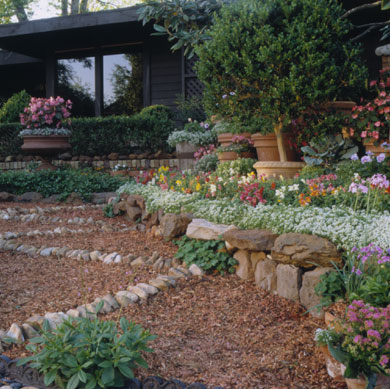
Landscaping your yard is easily achievable if you break it into bite-sized work portions. Although you should have your results in mind before you start, don't hope to do it all at one sitting. Our example shows how you can turn a naked front yard into a full landscape in five phases, which can be done in consecutive years or on a timeline that matches your budget.
Each phase costs about $1,000-$1,500, depending on the size of plants you purchase and where you buy them. The last two stages, fueled by perennials and structures, may cost more than $2,000. Apply our procedure to your yard for a great new landscape in a relatively little bit of time.
No matter how impatient you may be to get those flowerbeds abloom, tend to the basics first. Get the terrain -- soil and drainage -- established. We regraded along the front of the house, hiding more of the foundation and creating enough of a mound so it can easily be dug out in the future as a terrace. We put in the hardscape: a new patio. And we had a landscape plan professionally prepared, so we can follow the blueprint to success.
Find even more easy landscaping ideas.
The plan includes irrigation, which was done now so the trenches can be dug, the pipes laid, and the irrigation heads placed before the gardens actually take shape. The entire scheme is seeded, so there will be something besides mud to look at -- and walk through -- as the plans are implemented. The grass will be easy to remove later.
continue reading below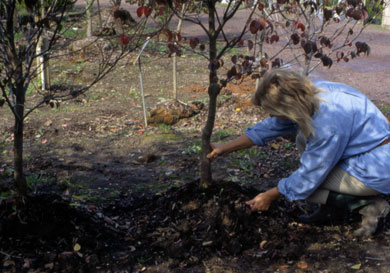 Plant trees and annuals now, andbuild beds and paths.
Plant trees and annuals now, andbuild beds and paths.
Plant your major trees. They need to get established and, as they grow taller, you will have a better idea of how to plan the size and location of your beds. If you really want your landscape to look full at the end of this project, spend a little more for larger trees. The rest of the landscape will catch up. For now, leave a mulch bed around each tree (though don't push it up right against the trunk) to mark where the flowerbeds will be in the future. And build your beds, paths, and terraces.
If you want a retaining wall or raised bed, install it now. Forget the perennials, however. They will not have much impact at this stage and will run the budget up considerably. Instead, use mulch in your new garden areas, and if you must have a splash of color, fill some planters with annuals.
Learn how to build a raised bed.
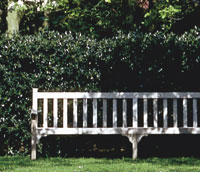 Shapely shrubs like these givecharacter to a yard.
Shapely shrubs like these givecharacter to a yard.
Purchase and plant all of your deciduous and evergreen shrubs next. It's important to have a mix of the two types to extend your seasons of interest -- especially important for a front facade. You can buy small plants -- they will grow quickly. A small, $20 red-twig dogwood will probably be full-size before you finish the rest of the landscape phases.
Position the shrubs as though they are full-size, leaving ample room for them to expand, plus extra space around and between them for your future perennials. Mulch around the shrubs for now. The shrubs have more bang for less cost than perennials. This will create a setting, and you will begin to get a real taste of how the final landscape will appear. Again, you can tuck a few annuals in the planters or add some containers for your flower fix.
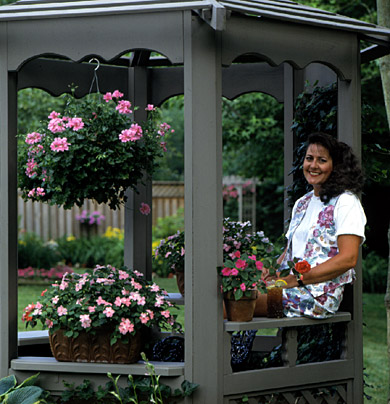 There's no match for the joy andcolor flowers add to your yard.
There's no match for the joy andcolor flowers add to your yard.
Now you can buy your perennials. But be prepared for sticker shock. Ready for a warm-up jolt? A single daylily will probably cost from $9 to $20. One 3-inch Rudbeckia can cost $6. One sprig of ornamental grass can cost $9-$15. And it will take more than you think to fill an area. For instance, you will need about 12 bellflowers (Campanula carpatica) to fill a 2x2-foot space. At about $6 per plant, that's $72 for 4 square feet, although you can usually get discounts if you buy in bulk. Just a 5-foot-deep border along a typical house foundation could hold 150 square feet of planting space. To ease the budget, leave some gaps and let the plants grow into them. Or, search for some cuttings and divisions from gardening friends.
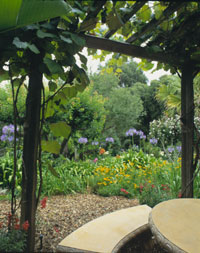
We added some of the decorative structures last. A pergola over the front entry balances the house with the now moderate-size trees. A privacy fence runs along the side of the house, and a bench tucks into the scheme. If you still have a few dollars left in your landscaping wallet, you can fill the planters with a blend of perennials and annuals.
Chances are, you will discover at this point that a landscape is never finished. You may change your mind about which plants you want or decide to enlarge a bed. You may want to add an arbor, pond, or sculpture. Or, buoyed by this success, you may be ready to take the backyard. Just give yourself an annual landscaping allowance, and go at it one step at a time.
Where you can, especially working with a small space, look for those special extras that can do two jobs for the price of one. Here are some examples:
It can be tough to dream of a lush landscape, yet have to look at a spindly 3-foot tree you just planted instead. The good news is there are some things you can do for quick impact.
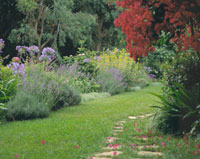 Plant a mix of annuals andperennials to prolong the colorfulseason.
Plant a mix of annuals andperennials to prolong the colorfulseason.
Copyright © www.100flowers.win Botanic Garden All Rights Reserved